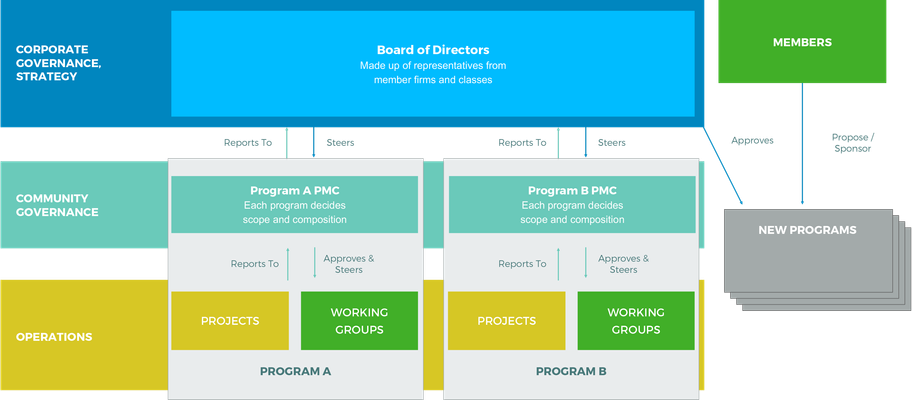Foundation Structure - ARCHIVED
Deprecated content
This content might be obsolete as the page was archived following deprecation of the concept of FINOS Programs in early 2020. For the latest on FINOS Corporate Governance please refer to the FINOS website while for the Community Governance check the FINOS Community Github Repository.
The Foundation's governance is split into two key areas:
- Corporate Governance
- Community Governance
The material on this page focuses exclusively on how the latter (Community Governance) is performed by the Foundation's various bodies.
Overview
Due to the broad scope of the Foundation (i.e. open collaboration across the entire Financial Services industry), a 3-level structure has been adopted, comprising a Strategic level, a Community Governance level, and an Operational level:
Board of Directors
At the highest level is the Board of Directors, broadly responsible for the overall strategy and mission of the Foundation, though generally not involved in the day-to-day technical activities of the community. The Board typically meets quarterly, and as part of those meetings receives status updates from each of the Programs, as well as reviewing and approving any new program proposals that have been submitted by member organisations.
Programs
The next level down are /wiki/spaces/FINOS/pages/77955365, which are Foundation-hosted strategic initiatives focused around a topic of interest and/or technology. Examples include FDC3 and Voice (topic-focused Programs), and Hadouken and Symphony (technology-focused Programs). Programs are best thought of as a container for projects and working groups focused on similar topics, and a venue for fostering collaboration between those activities where appropriate.
The community governance model defines a Program Management Committee (PMC) made up of the leads and chairs of each of the Project and Working Groups within that Program. The PMC is responsible for approving the contribution of new projects and working groups into the Program, facilitating the smooth operation of all Projects and Working Groups within the Program, and ensuring that the Foundation's principles of Openness and IP Cleanliness, Meritocracy, and Security and Compliance are met at all times.
Like the Board of Directors, the PMC is not generally involved in the day-to-day technical activities of the community. Their primary responsibilities are around community governance, rather than the creation of new intellectual property.
Projects and Working Groups
Projects and Working Groups represent the tactical work streams within the Foundation - this is where the actual work gets done.
- Projects produce functioning open source software.
- Working Groups produce openly licensed non-source-code assets (typically things like standards documents, protocol definitions, object models, etc.)
Projects and Working Groups are always constituted within a single Program, and are expected to be aligned with the scope of that Program - so for example Projects and Working Groups within the Voice Program would be expected to be involved in developing voice technologies, voice metadata and API standards, or workflow enablement between voice systems and other systems.
Within the boundaries defined by the Program's Operations Policy, Projects and Working Groups are predominantly autonomous in their day-to-day operation. Prioritization and roadmap planning, development methodologies and standards, staffing, meeting schedules, choice of tools and techniques etc. are all the responsibility of each Project or Working Group. This level of independence is intended to maximize momentum and progress, and minimize frictions (both bureaucratic and otherwise).
Need help? Email help@finos.org we'll get back to you.
Content on this page is licensed under the CC BY 4.0 license.
Code on this page is licensed under the Apache 2.0 license.
